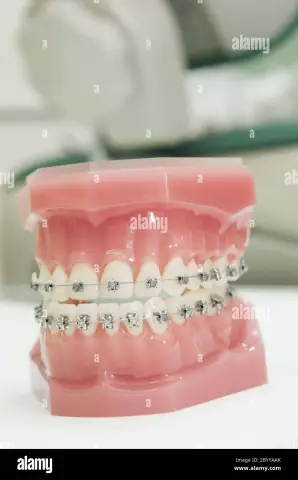- Author Rachel Wainwright [email protected].
- Public 2023-12-15 07:39.
- Last modified 2025-11-02 20:14.
Osteomyelitis of the jaw
Brief description of the disease

Osteomyelitis of the jaw is one of the most dangerous diseases of the bone tissue. It affects all elements of the bone, is accompanied by the development of inflammatory and infectious processes, and has many serious complications. Suffice it to say that osteomyelitis of the jaw often leads to generalization - a phenomenon in which not only a certain area of the bone marrow suffers, but the entire human skeletal system as a whole.
Bone tissue lesions have been known to doctors for a long time. The first mentions of osteomyelitis of the jaw are found in the writings of Avicenna, Galen, Hippocrates and Paracelsus, but the causes and methods of treating inflammation were discovered only at the end of the 19th century. It was then that the researchers concluded that the osteomyelitis of the lower jaw is caused by Staphylococcus aureus. Nowadays, gram-negative bacteria, Pseudomonas aeruginosa, Klebsiella and Escherichia coli have been added to the number of infectious agents. In addition, when diagnosed with osteomyelitis of the jaw, treatment implies antiviral therapy, since in more than 50% of reported cases, inflammation develops against the background of viral infections.
As for the ways of penetration of bacteria and viruses into the body, then, as a rule, they seep through a bad tooth, or through the blood as a result of injury to the jaw apparatus.
Types of osteomyelitis of the jaw
The odontogenic form of the disease is a consequence of advanced caries. That is why timely filling of tooth canals is so important. From the carious cavity, the infection enters the pulp, and then into the bone tissue directly through the tooth root. In addition, microorganisms can spread through the lymphatic vessels. In 70% of cases, the patient develops odontogenic osteomyelitis of the lower jaw. The remainder of the lesions are in the upper jaw.
Hematogenous osteomyelitis of the jaw is observed when the infection is transferred from the primary focus of inflammation to healthy tissue sites. Sources of infection are: tonsillitis and other chronic diseases, acute infections, inflammation.
Acute osteomyelitis of the jaw is a consequence of the body's reaction to infection. The patient experiences headache, malaise, weakness, lack of appetite, and sleep problems. Also, people have an increase in body temperature up to 38 degrees. When diagnosed with acute osteomyelitis of the jaw, treatment should begin as soon as possible, since the patient cannot eat normally due to constant pain and discomfort when chewing food. In addition, as the infectious process develops, a person has reddening of the oral mucosa, an increase in lymph nodes and strong mobility of the teeth adjacent to the focus of inflammation. In some cases, acute osteomyelitis of the lower jaw leads to damage to the spleen and liver.
Subacute osteomyelitis of the jaw develops in the absence of adequate treatment for the acute form. The patient develops fistulas and sequesters - dead skin areas. In this case, the typical symptoms of inflammation may dull due to the outflow of fluid and pus, but this does not mean anything, since the inflammatory process in the bone tissue continues, and every day it becomes more and more dangerous.
Chronic osteomyelitis of the jaw - lasts a long time, and for some time the patient has all the external signs of complete recovery. Of course, this is just an appearance, since the inflammatory process continues to develop and, sooner or later, leads to new exacerbations, the formation of fistulas, the rejection of dead tissue and the formation of sequesters.
Osteomyelitis of the jaw symptoms
Summarizing all of the above, we can distinguish several main symptoms of the disease:
- the presence of signs of poisoning (headache, poor sleep, weakness, fever);
- pain in the area of the infected tooth, which tends to increase with palpation or tapping;
- tooth mobility in the area of infection;
- swelling of the mucous membrane;
- swollen lymph nodes.
Osteomyelitis of the jaw - treatment of the disease
First of all, the treatment process involves the removal of the infected tooth. Note that osteomyelitis of the lower jaw refers precisely to those cases when tooth extraction is absolutely necessary, otherwise the inflammation process will spread to healthy tissues and it will be much more difficult to stop it. Also, patients are prescribed an early periostotomy - a procedure in which incisions are made in the periosteum for the unhindered removal of exudate (fluid that forms during the development of infection and tissue death). Patients are shown taking antibiotics, washing the bone cavity with antiseptics and symptomatic therapy. In severe cases, doctors decide on the surgical removal of sequesters.
YouTube video related to the article:
The information is generalized and provided for informational purposes only. At the first sign of illness, see your doctor. Self-medication is hazardous to health!






